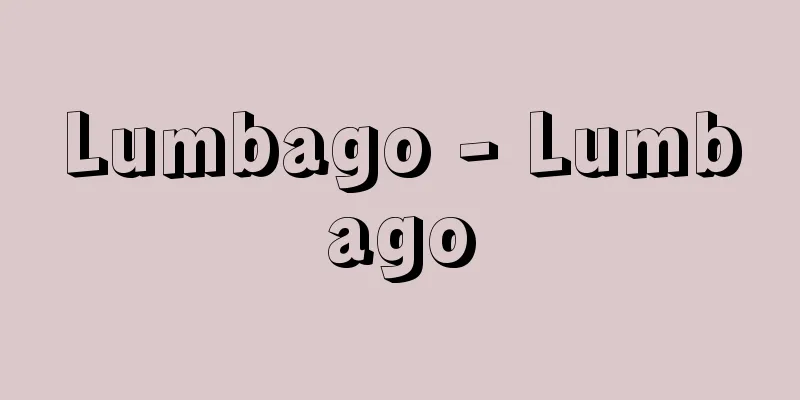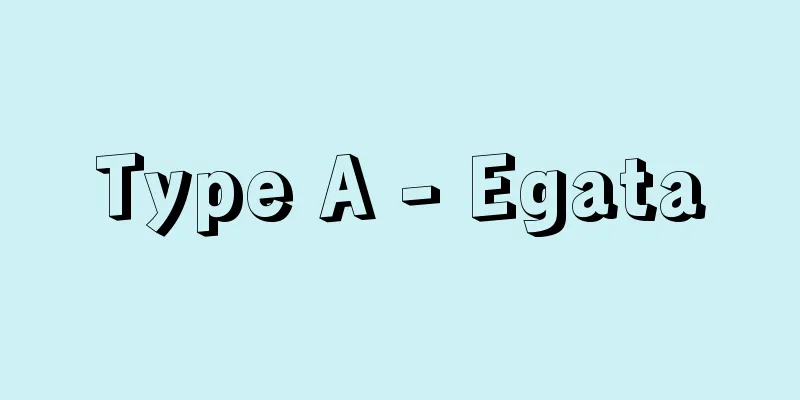Lumbago - Lumbago

What is the disease?This is lower back pain that is not accompanied by neurological symptoms such as pain in the lower limbs, and no particular organic lesion is identified as the cause. There are two types of lower back pain: acute, commonly known as "lumbago," and chronic lower back pain, which is mild but tends to get worse and worse again. What is the cause? Acute lower back pain often occurs suddenly due to involuntary movements, especially twisting movements, while chronic lower back pain is caused by fatigue of the lower back muscles due to poor posture in daily life. Testing and diagnosisBased on the interview and physical examination, the diagnosis is based on exclusion by imaging such as X-rays. The diagnosis of lower back pain is made by making sure that there are no other diseases that need to be identified and by making sure that no other serious diseases, including internal organ diseases, are overlooked. Treatment methodsAcute back pain usually improves within a few days with rest and medication. Treatment for chronic lower back pain mainly involves improving daily activities and doing exercises for lower back pain. Nonsteroidal anti-inflammatory drugs and muscle relaxants may be used as appropriate, but in many cases, lower back pain can be significantly improved by simply paying attention to daily activities. Exercises for lower back pain are also important for preventing the recurrence of lower back pain. ① Precautions in daily life (Figure 68) When lifting a heavy object, lift it as close to your body as possible. By shortening the distance between your stomach and the object, you reduce the strain on your lower back muscles. When sitting in a chair, the lumbar If you work while standing, use a footstool to prevent lumbar lordosis and reduce muscle fatigue. By keeping your pelvis horizontal, you can reduce lumbar lordosis and reduce muscle fatigue in your lower back. Either way, it's important to avoid staying in the same position for long periods of time. ② Exercises for lower back pain The purpose of exercises for lower back pain is to 1) improve poor posture, 2) strengthen abdominal and back muscles, and 3) improve flexibility of soft tissues. There are four types of exercises for lower back pain, as shown in Figure 69. Note that when the lower back pain is severe, it is best not to do the exercises. Exercise A focuses on the abdominal muscles, gluteal muscles (buttocks muscles), and hamstrings (back thigh muscles). While keeping your hips from rising, exert enough force and then release it. Improving poor posture through this exercise reduces lumbar lordosis and reduces the strain on the lower back muscles. Exercise B is aimed at strengthening the abdominal muscles. This increases intra-abdominal pressure, which is like creating a corset with your own muscles, and helps to stabilize the spine. The knee and hip joints should be bent when doing this exercise. If you perform this exercise with your knee and hip joints straight, it will actually increase the lordosis of the lumbar spine. Also, to strengthen your abdominal muscles, it is not necessary to raise your upper body to a vertical position; it is enough to maintain the position for about 5 seconds with your shoulders slightly raised. Exercise C is a stretch for the lower back and spine to improve the flexibility of the soft tissues around the lumbar spine. This stretch is important because lower back pain often results in contractures in the muscles of the lower back and spine, and suddenly bending forward can easily cause lower back pain. In exercise D, we strengthen the back muscles. Place a pillow under your lower abdomen and use it as a fulcrum to arch your lumbar spine. You don't need to arch your back too much, and if the pillow is too large, it can cause excessive flexion of the lumbar spine, which can lead to pain, so be careful. It is important to start by choosing 2-3 types of exercises from A-D, and doing them 5-10 times twice a day, in the morning and evening, and then gradually increase the types and number of times depending on the situation. What to do if you notice an illnessThis is a condition in which the pain is likely to improve if you actively reduce the load on the lumbar spine caused by unnatural postures or maintaining the same posture, control your weight, and strengthen your lumbar, back, and abdominal muscles. However, even simple lower back pain can be an early symptom of a serious illness. Even if your symptoms are mild, you should visit an orthopedic surgeon to receive a proper diagnosis and advice. Shinichiro Kubo "> Figure 68 Points to note in daily life "> Figure 69 Exercises for lower back pain Source: Houken “Sixth Edition Family Medicine Encyclopedia” Information about the Sixth Edition Family Medicine Encyclopedia |
どんな病気か下肢痛などの神経症状を伴わない腰痛のうち、とくに原因となる器質的病変が認めないものです。 一般的に「ぎっくり腰」と呼ばれる急性腰痛症と、痛みは軽いものの強くなったり楽になったりを繰り返す「慢性腰痛症」があります。 原因は何か 急性腰痛症は不意の動作、とくにひねり動作で急に起きることが多く、慢性的な腰痛症は日常生活での不良姿勢による腰の筋肉の疲労などが原因です。 検査と診断問診と診察所見を中心に、X線検査などの画像診断による除外診断になります。ほかに特定すべき疾患がないことを確認し、内臓疾患を含むほかの重大な病気を見逃さないようにして腰痛症という診断がなされます。 治療の方法急性腰痛症は、安静や投薬により通常数日で軽快します。 慢性的な腰痛に対しては、主に、日常生活動作の改善、腰痛体操などの治療が行われます。非ステロイド性消炎鎮痛薬や筋弛緩薬が適宜使用されることもありますが、多くの場合、日常生活動作に注意するだけで腰痛はかなり改善します。腰痛の再発防止のためにも腰痛体操は大切です。 ①日常生活の注意点(図68) 重いものを持ち上げる際は、できるだけ体に引きつけて持ち上げます。おなかから対象までの距離を短くすることで、腰背部の筋肉にかかる負担は小さくなります。 椅子に座る場合は、腰椎の 立ち仕事の場合は、腰椎の前弯防止と筋肉の疲労を軽減させるために、足台を使うようにします。骨盤を水平に保つことで腰椎の前弯を減少させ、腰部の筋肉の疲労を減らすことができます。 いずれにせよ、同じ姿勢を長時間とり続けないようにすることが大切です。 ②腰痛体操 腰痛体操の目的は、①不良姿勢の改善、②腹筋・背筋の強化、③軟部組織の柔軟性の獲得があげられます。図69に示すように4種類の腰痛体操があります。なお、腰痛が強い時は、腰痛体操を行わないのが基本です。 Aの体操は、腹筋、殿筋(お尻の筋肉)、ハムストリングス(大腿部後面の筋肉)に力を入れるようにします。腰が浮かないようにしながら、十分に力を入れたあとに力を抜きます。この運動による不良姿勢の改善は、腰椎の前弯を減少させ、腰背部の筋肉に対する負荷を小さくさせます。 Bの体操は、腹筋の強化を目的にしています。これにより腹腔内圧を上昇させ、自らの筋肉によるコルセットを作るようなもので、脊椎の安定性を得ることができます。膝関節と股関節は屈曲して行うようにします。膝関節と股関節をまっすぐに伸ばしてこの運動を行うと、逆に腰椎の前弯が増強してしまうからです。また、腹筋力強化には必ずしも上半身を垂直位まで起こすことはなく、肩が少し浮く程度で5秒ほど姿勢を維持すればよいでしょう。 Cの体操は、腰背部のストレッチで腰椎周囲の軟部組織の柔軟性を得るために行います。腰痛症では腰背部の筋肉が拘縮を起こしていることが多く、急に体を前かがみさせると腰痛を生じやすいので、このストレッチは大切です。 Dの体操では、背筋の強化を行います。下腹部に枕を置いて、これを支点に腰背筋の反り返り運動をします。強く反り返る必要はありませんし、枕が大きすぎると腰椎の過度の屈曲が起こり、痛みを誘発させることがあるので注意します。 A~Dの体操のうち2~3種類を選んで、朝・晩の1日2回それぞれ5~10回程度から開始して、状況に応じて種類と回数を増やしていくことが大切です。 病気に気づいたらどうする無理な姿勢や同一姿勢の持続などの腰椎への負荷を減らしたり、体重コントロール、腰背筋・腹筋の筋力訓練などを積極的に行うことで痛みが軽快する可能性の高い病態です。一方、単なる腰痛でも重い病気の初期症状であることもあります。軽い症状でも整形外科を受診し、確実な診断とアドバイスを受けましょう。 久保 紳一郎 "> 図68 日常生活の注意点 "> 図69 腰痛体操 出典 法研「六訂版 家庭医学大全科」六訂版 家庭医学大全科について 情報 |
Recommend
Sky - Sora
[given name] A space that stretches far above one&...
Strange Particle - Kimyōnarīshi
…In 1947, British scientists Rochester and Butler...
Black Muslim
A secret society of black (African-American) peopl...
Iseria scale insect - Iseria red scale insect
... Infested plants suffer direct damage from the...
Cousin le Fils, J.
...there are also works by Jean Cousin le Fils (w...
Estrildidae
...They are hardy, seed-eating birds that are eas...
Sayyid Quṭb (English spelling)
…However, during this time, under Hasan Isma'...
Local Legend Records - Local Legend Records
This is one of the representative local books of ...
Kanshinji Temple
Located in Teramoto, Kawachinagano City, Osaka Pr...
Congenital pyloric stenosis - congenital pyloric stenosis
The correct name is congenital hypertrophic pylori...
Han Huang - Travel
A Chinese government official in the middle Tang ...
Lipoprotein (Lipoprotein)
A general term for lipid and protein complexes. Al...
Lecture ceremony - Koushiki
Among the ritual procedures for Buddhist ceremoni...
Sutherland, EH (English spelling)
... American theories of crime and delinquency in...
Entering
The number of pieces. (Collected Words (around 179...









